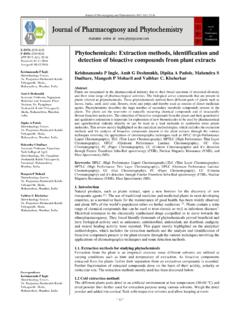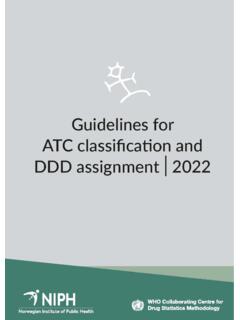Transcription of 2017 Ideal International E
1 2017 Ideal International E Publication Pvt. Ltd. 427, Palhar Nagar, RAPTC, VIP-Road, Indore-452005 (MP) INDIA Phone: +91-731-2616100, Mobile: +91-80570-83382 E-mail: , Website: Title: Sustainable development Author(s): Dr G Tirumala Vasu Deva Rao Edition: First Volume: I Copyright Reserved 2017 All rights reserved. No part of this publication may be reproduced, stored, in a retrieval system or transmitted, in any form or by any means, electronic, mechanical, photocopying, reordering or otherwise, without the prior permission of the publisher. ISBN: 978-81-934005-6-2 Sustainable Development iii Ideal International E- Publication PREFACE This edited book, Sustainable Development, is divided into two parts. Part I of the book focuses on the Biodiversity- sustainable development, Biological diversity - or biodiversity - is the term given to the variety of life on Earth and the natural patterns it forms.
2 This diversity is often understood in terms of the wide variety of plants, animals and microorganisms, but also includes genetic differences within species and the variety of ecosystems. Biological resources are the pillars upon which we build civilizations. As a result, our personal health, and the health of our economy and human society, depends on the continuous supply of various ecological services that would be extremely costly or impossible to replace. Any sustainable development framework must provide the enabling conditions for the conservation and sustainable use of biodiversity, for more equitable sharing of benefits, and for reducing the drivers of biodiversity loss Part II of the book focuses on the Socio-Economic factors- sustainable development, One of the ways to reach the balance between the production, consumption and the natural environment is recycling, treated as an essential element of the mutual dependencies of dynamic relation between theses spheres, and thus at the same time an important condition of the human society existence, both in the global and the local dimension.
3 The socio-economic aspect of the sustainable development shows that the broadly understood ecological problems were discussed within a deep human, social and philosophical perspective, and thus it covered the spheres of: values, attitudes, behaviours, as well the ecological consciousness. The book came into light due to the authors who have contributed their work. Therefore, we acknowledge and thank the contributing authors; In case of any error we would like to receive feedback so that it could be taken into consideration for next work. (Dr. Tirumala Vasu Deva Rao) Sustainable Development iv Ideal International E- Publication Title of Paper Author Page no THEME: BIODIVERSITY - SUSTAINABLE DEVELOPMENT 1 Conservation Of Biodiversity S. Padmavathi 2 2 Environmental Protection Dr. P. Manohar 7 3 Economic importance of Non-Timber Forest Products (NTFPs) in India A. Nageswara Rao 11 4 Promoting Spirituality for Mental Health and Wellbeing Role of Media Dr.
4 Uma Rani 17 5 Health Foods E. Nagarajan 23 6 Role of Biodiversity in Sustainable development Dr. Kumara Sridevi 26 7 Climate Change Dr. G. Swathi 30 THEME: SOCIO-ECONOMIC FACTORS -SUSTAINABLE DEVELOPMENT 1 Welfare Schemes for the Scheduled Castes Dr. 33 2 Government Schemes/Programs for Tribal Women Empowerment M. Kiran Kumar Raju 36 3 Impact of Globalization on Tribal Communities in India A. Nageswara Rao 41 4 Sustainable Tourism Dr. Vasu Deva Rao 46 5 Spirituality and Wellbeing A Historical Perspective Dr. P Bhaskar 48 6 Quality of Work Life and Employees Satisfaction Dr. T. Suneetha 53 7 Rural Poverty in India: An Outlook E. Nagarajan 57 8 Socio- economic development of Scheduled Tribes (STs) in India - Programmes and Schemes A. Nageswara Rao 63 9 Sustainable Development Dr. K. Krisnaiah 71 10 Women Empowerment in Scheduled Caste Women: Problems and Challenges Dr. G. Swathi 75 About Author 78 Sustainable Development 1 Ideal International E- Publication Theme: BIODIVERSITY - SUSTAINABLE DEVELOPMENT Sustainable Development 2 Ideal International E- Publication CONSERVATION OF BIODIVERSITY S.
5 PADMAVATHI LECTURER IN BOTANY, GOVERNMENT DEGREE COLLEGE, NAGARI INTRODUCTION India, a megadiverse nation, is one of the richest nations in terms of biological diversity. India owes this to its position in the tropical and subtropical latitudes. India has a great diversity of natural ecosystems ranging from the cold and high Himalayan regions to the sea coasts; from the wet north-eastern green forests to the dry northwestern arid deserts; with different types of forests, wetlands, islands and the oceans. India consists of fertile river plains and high plateaus and several major rivers, including the Ganges, Brahmaputra and Indus. The diverse physical features and climatic situations have formed ecological habitats like forests, grasslands, wetlands, coastal and marine ecosystems and desert ecosystems, whichharbour and sustain immense biodiversity. The country is also one of the 12 primary centres of origin of cultivated plants and domesticated animals.
6 Why Conserve Biodiversity? As we all know by now, Biodiversity is essential for maintaining the ecological functions, including stabilizing of the water cycle, maintenance and replenishment of soil fertility, pollination and cross-fertilization of crops and other vegetation, protection against soil erosion and stability of food producing and other ecosystems. Conservation of biological diversity leads to conservation of essential ecological diversity to preserve the continuity of food chains. Biodiversity provides the base for the livelihoods, cultures and economies of several hundred millions of people, including farmers, fisher folk, forest dwellers and artisans. It provides raw material for a diverse medicinal and health care systems. It also provides the genetic base for the continuous up-gradation of agriculture, fisheries, and for critical discoveries in scientific, industrial and other sectors.
7 The rapid erosion of biodiversity in the last few decades has impacted on the health of the land, water bodies and people. Biodiversity is a wealth to which no value can be put. In the final analysis, the very survival of the human race is dependent on conservation of biodiversity. It is evident that this invaluable heritage is being destroyed at an alarming rate due to several reasons. Measures are being taken up at national and International levels to address this issue. The Earth Summit produced a plan of action on a number of issues (Agenda 21) including conservation of biodiversity during the 21st and sustainable use of biological resources based on local knowledge systems and practices is ingrained in Indian ethos. The country has a number of alternative medicines, like Sustainable Development 3 Ideal International E- Publication Ayurveda, Unani, Siddha and Homeopathic systems which are predominantly based on plant based raw materials in most of their preparations and formulations.
8 herbal preparations for various purposes including pharmaceutical and cosmetic form part of traditional biodiversity uses in India. There are several strategies which are adapted for conservation of Biodiversity. Some of these are: 1. Legislation Formal policies and programmes for conservation and sustainable utilisation of biodiversity resources dates back to several decades. The concept of environmental protection is enshrined in the Indian constitution in articles 48a and 51a(g). Major central acts relevant to biodiversity include: Environment Protection Act, 1986 Fisheries Act, 1897 Forest Act, 1927 Forest (Conservation) Act, 1980 Wildlife (Protection) Act 1972 and Wildlife (Protection) Amendment Act 1991 The various central Acts are supported by a number of state laws and statutes concerning forests and other natural resources. The policies and strategies directly relevant to biodiversity include National Forest Policy amended in 1988, National Conservation Strategy and Policy Statement for Environment and Sustainable Development, National Agricultural Policy, National Land Use Policy, National Fisheries Policy, National Policy and Action Strategy on Biodiversity, National Wildlife Action Plan and Environmental Action Plan.
9 2. In-situ Conservation Conserving the animals and plants in their natural habitats is known as in situ conservation. The established natural habitats are: National parks and sanctuaries Biosphere reserves Nature reserves Reserved and protected forests Preservation plots Reserved forests Approximately, % of the total geographical area of the country has been earmarked for extensive in-situ conservation of habitats and ecosystems. A protected area network of 85 national parks and 448 wildlife sanctuaries has been created. The results of this network Sustainable Development 4 Ideal International E- Publication have been significant in restoring viable population of large mammals such as tiger, lion, rhinoceros, crocodiles and elephants. 3. Ex-situ Conservation Ex-situ conservation of plants and animals preserve/ or protect them away from their natural habitat. This could be in zoological parks and botanical gardens or through the forestry institutions and agricultural research centres.
10 A lot of effort is under way to collect and preserve the genetic material of crops, animal, bird and fish species. This work is being done by institutions such as the National Bureau of Plant Genetic Resources, New Delhi, the National Bureau of Animal Genetic Resources, etc. Reintroduction of an animal or plant into the habitat from where it has become extinct is another form of ex situ conservation. For example, the Gangetic gharial has been reintroduced in the rivers of Uttar Pradesh, Madhya Pradesh and Rajasthan where it had become extinct. Seed banks, botanical, horticultural and recreational gardens are important centres for ex situ conservation. Ex-situ conservation measures complement in-situ conservation. 4. Recording Indigenous Knowledge The lives of local communities are closely interwoven with their environment, and are dependent upon their immediate resources for meeting their needs.


